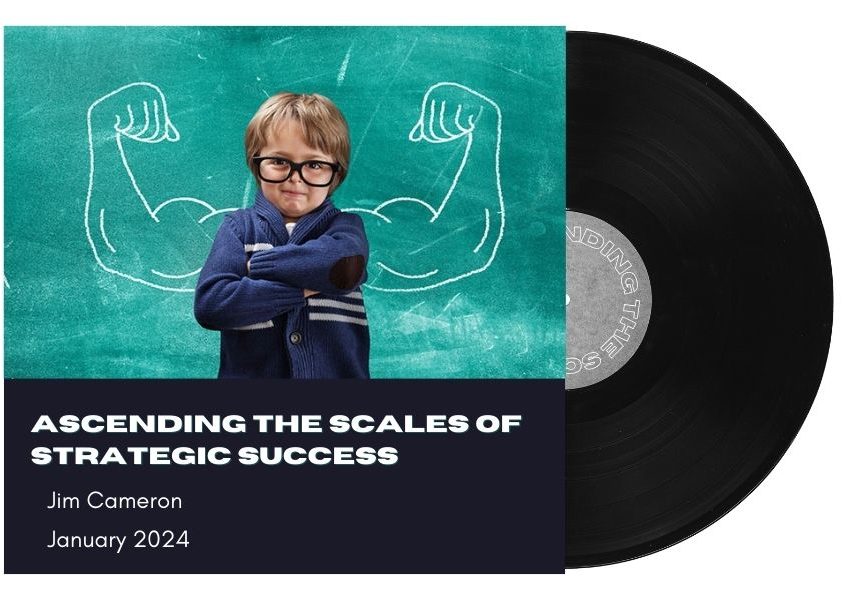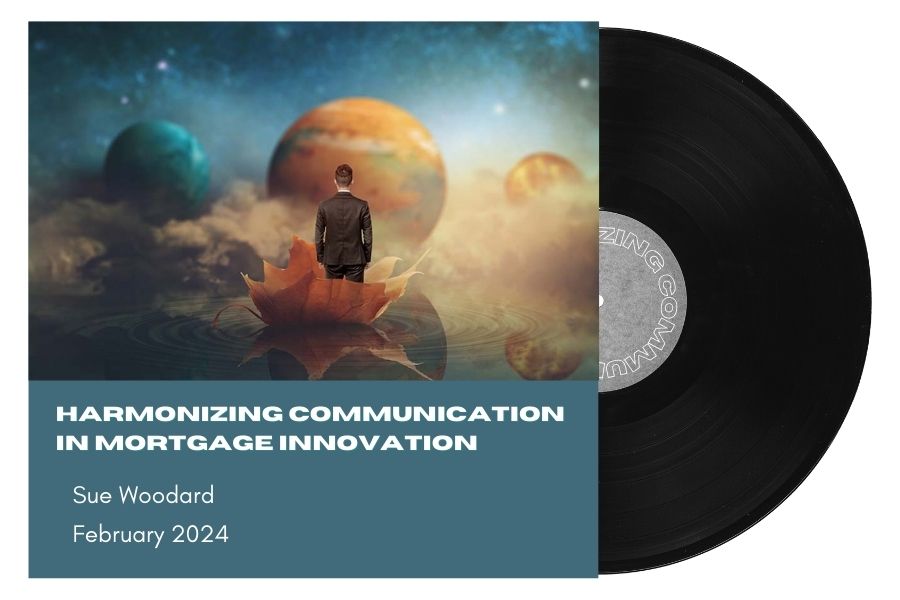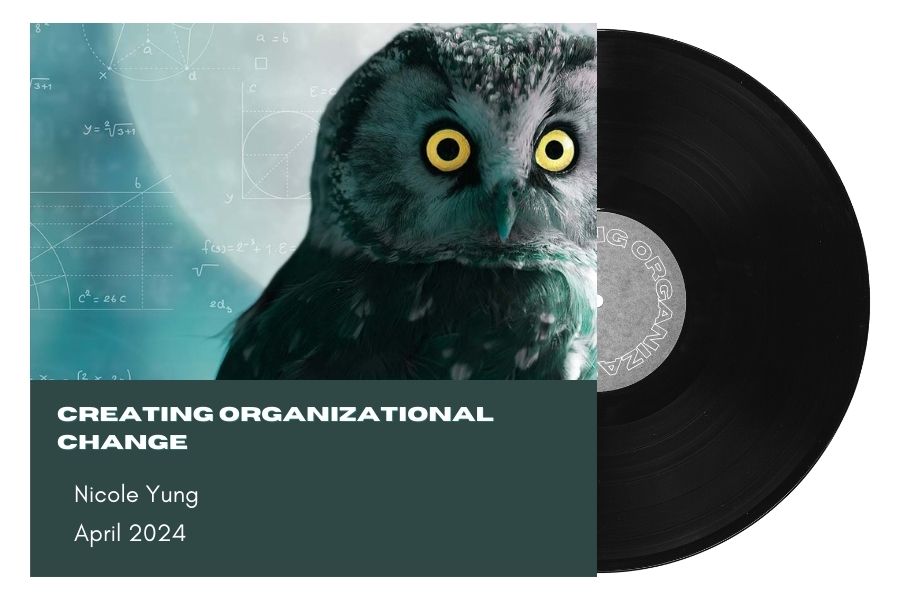As we approach the end of 2024, we’re excited to share our “Greatest Hits” compilation. This recap highlights the thought-provoking and impactful articles we published, showcasing the key insights, trends and discussions that defined our year. Whether you’re revisiting favorites or catching up on what you missed, this overview provides a curated look at the ideas that shaped our industry and set the stage for 2025.
 Senior Partner Jim Cameron launched the year with a somber serenade and thought-provoking analysis of the mortgage industry, drawing inspiration from Abraham Maslow’s hierarchy of needs.
Senior Partner Jim Cameron launched the year with a somber serenade and thought-provoking analysis of the mortgage industry, drawing inspiration from Abraham Maslow’s hierarchy of needs.
In his article “Maslow and Mortgages — The Path to Actualization in Today’s Market,” Cameron introduced a novel framework for understanding lender development. He outlined a similar hierarchy that recommends lenders get back to consistent profits before embarking on their longer-term strategic goals.
Jim challenged the industry to view strategic growth through a hierarchical lens, proposing a “Mortgage Lending Hierarchy” that prioritizes fundamental business health before pursuing ambitious long-term goals. His key message was simple yet powerful: profitability must precede expansion.
Lenders that are still experiencing ongoing production losses should prioritize short-term tactical improvements to make their way back to consistent profitability. Only after establishing that they are squarely in the black and generating reliably positive cash flows can they confidently develop and implement strategic long-term plans.
 In February, Senior Advisor Sue Woodard composed a power ballad about a critical challenge in the mortgage industry: the communication breakdown between mortgage lenders and their technology partners.
In February, Senior Advisor Sue Woodard composed a power ballad about a critical challenge in the mortgage industry: the communication breakdown between mortgage lenders and their technology partners.
In “Step into Our Office: Couples Therapy for Mortgage Lenders and Tech Vendors,” Sue compares the miscommunication often seen between mortgage lenders and their technology partners to couples in need of marriage counseling. In the article, she takes on the role of “therapist” to help both lenders and vendors unpack the key areas of concern. Her article offers expert insights and practical strategies for improving dialogue and mutual understanding.
Effective communication is the cornerstone of successful technology partnerships. Both lenders and technology providers should:
· Schedule regular business reviews
· Maintain open, honest communication channels
· Proactively discuss challenges and frustrations
· View challenges as opportunities for collaborative improvement
STRATMOR’s Solution Provider Advisory (SPA) program stands ready to help technology partners hear, understand, and better respond to the needs of the lending community. If you know of a technology partner who might benefit from participating in the SPA Program, encourage them to reach out to STRATMOR.
 STRATMOR Principal Advisors Jennifer Smith and Jennifer Fortier dropped a playful duet in March of this year in which they tackled a critical challenge facing mortgage lenders: the reluctance to examine and improve operational processes. They emphasized the importance of thoughtful planning, execution and ongoing support to ensure successful and sustainable changes in processes. In “On This Episode of ‘Between Two Jennifers’ — Parrying the Pitfalls of Process Improvement,” they offer a candid look at the challenges and opportunities in process optimization.
STRATMOR Principal Advisors Jennifer Smith and Jennifer Fortier dropped a playful duet in March of this year in which they tackled a critical challenge facing mortgage lenders: the reluctance to examine and improve operational processes. They emphasized the importance of thoughtful planning, execution and ongoing support to ensure successful and sustainable changes in processes. In “On This Episode of ‘Between Two Jennifers’ — Parrying the Pitfalls of Process Improvement,” they offer a candid look at the challenges and opportunities in process optimization.
The duo highlighted why many lenders avoid process reviews, citing reasons such as perceived cost, lack of expertise, and inertia. “It takes real grit to want to look under the hood with an objective eye and to do so on a regular basis. I see operational reviews as an annual check-up or semi-annual teeth cleaning,” Jen Smith advised. “Lenders need to get in front of potential issues before they become a real problem — or discover a problem early enough to easily fix it.”
Drawing from STRATMOR’s extensive MortgageCX data, they identified seven key process mistakes that can directly impact repeat business and referrals. Their recommendations included: using diagnostic tools like a fishbone diagram to root out process issues, focusing on user adoption and change management, and creating sustainable improvement strategies.
The practice of change management has many tools to help promote and reinforce adoption so it sticks. By identifying a specific leader to guide the implementation of change management techniques, lenders can greatly improve their chances of creating lasting, meaningful improvements. Ultimately, the method(s) employed need to be tailored to the type of change, the lender’s organizational culture, and the magnitude of impact.
Don’t delay your annual checkup. If you need help tailoring your processes, including review, redesign, implementation, and adoption, the team at STRATMOR is ready to help.
 Senior Partner Nicole Yung’s rousing anthem about the importance of sophisticated data analysis was the hit of Spring.
Senior Partner Nicole Yung’s rousing anthem about the importance of sophisticated data analysis was the hit of Spring.
In “Amplify Your Vision to Illuminate Business Opportunities and Risks,” Nicole revealed how sophisticated data interpretation can transform organizational performance. She highlights three key strategies for leveraging data effectively: comprehensive benchmarking, thorough historical trend analysis, and strategic peer data comparison. Nicole emphasizes the power of transforming raw data into meaningful, actionable insights that enable mortgage lending executives to make more informed decisions and gain a competitive edge.
The teams in charge of data for lending organizations need to:
· Identify the most critical performance metrics
· Ensure data accuracy and timeliness
· Create accessible, clear data summaries
· Provide decision-makers with actionable insights
By treating data as a strategic asset, lending organizations can illuminate hidden opportunities and mitigate potential risks more effectively.
 In May, principal Tom Finnegan composed a track that explored strategic opportunities for financial institutions, such as banks and credit unions, in the tough mortgage market. His insights focused on business development strategies that can help financial institutions improve market share and profitability without relying on pricing, cost-cutting or operational changes. Most of Tom’s strategies revolve around improved execution of critical business development activities, rather than on new investments in technology or systems.
In May, principal Tom Finnegan composed a track that explored strategic opportunities for financial institutions, such as banks and credit unions, in the tough mortgage market. His insights focused on business development strategies that can help financial institutions improve market share and profitability without relying on pricing, cost-cutting or operational changes. Most of Tom’s strategies revolve around improved execution of critical business development activities, rather than on new investments in technology or systems.
In “All Hands on Deck: Action Ideas for Banks Navigating This Tough Mortgage Market,” Tom outlined a roadmap for banks to leverage their strengths and regain their competitive edge. He notes that banks possess natural advantages over independent mortgage banks (IMBs), including: large customer bases, financial strength and diverse product offerings. Despite these strengths, bank market share has declined due to weak mortgage marketing and limited internal referral programs, among other things. Tom’s tune highlights a critical weakness—many bank customers are simply unaware their bank offers mortgages.
Banks need to develop a clear mortgage delivery model. This begins with establishing well-defined, organization-wide goals to develop the right target operating model. Tom’s analysis emphasizes the importance of strategic planning, which should include defining specific objectives, targeting select customer segments, and creating a compelling value proposition.
 Far from being a “one hit wonder” Senior Partner Garth Graham released back-to-back hits this summer, starting with a cautionary tune for lenders waiting for a refinance wave to bail them out.
Far from being a “one hit wonder” Senior Partner Garth Graham released back-to-back hits this summer, starting with a cautionary tune for lenders waiting for a refinance wave to bail them out.
In “Why a Refi Wave Won’t Save Every Lender and How to Prepare,” Garth explains why the next refi wave will be different than past refi booms and warns that the anticipated refinancing surge is not a surefire solution for lenders’ financial challenges.
“I’ve talked with many lenders who believe at the core of their beings that as soon as the next wave of refinances hits the business, all of their problems will go away,” Garth says. “But that isn’t guaranteed.”
Garth offers several strategies lenders can employ to prepare for lower rates and the subsequent wave of refinances.
Prepare to compete for every loan. Lenders with retail and consumer direct channels need to ensure they’re well-managed, properly staffed and ready to compete aggressively when rates drop. Lenders without existing servicing relationships will need to step up their marketing to attract refinances. Critical to success will be delivering an exceptional customer experience and seriously examining current compensation structures. Lenders who cling to traditional compensation plans will find it very difficult to compete with the big call centers. Garth strongly recommends that lenders thoroughly evaluate and if needed, redesign their compensation plans.
 In his second hit of the summer, Garth looked at the other side of the coin — the purchase market — and similarly serenaded lenders about how a likely upcoming surge in purchase business will be unlike previous markets and why it won’t benefit all lenders equally.
In his second hit of the summer, Garth looked at the other side of the coin — the purchase market — and similarly serenaded lenders about how a likely upcoming surge in purchase business will be unlike previous markets and why it won’t benefit all lenders equally.
In “How to Win the Coming Battle for the Purchase Money Market,” Garth explains that the real estate industry is on the brink of a dramatic transformation, driven primarily by the ongoing legal battle between major real estate companies and the Department of Justice (DOJ) over consumer disclosures regarding buyer’s agents. These changes are poised to fundamentally alter how real estate agents and lenders interact.
Real estate agents are far and away the leading source of new purchase money mortgage business for lenders, but that dynamic is changing quickly, Garth says. “Most have traditionally waited for their business referral partners to bring them the deal. But that may not work in the future,” he explains.
Garth’s analysis sounds a clear warning: lenders must now proactively reevaluate their business models and strategic direction. “Most lenders don’t have sales teams made up of enough loan officers to directly generate purchase money business from consumers in a significant way,” he says.
Lenders need to proactively address the challenges associated with a transformed real estate industry and act now to position themselves for the future. As the industry faces unprecedented changes, Garth’s key message is clear: adapt or risk becoming a forgotten B-side.
 In a compelling composition about workplace well-being, Senior Partner Lisa Springer penned a powerful message about the critical role rest and recovery play in the success of any business, including the mortgage industry.
In a compelling composition about workplace well-being, Senior Partner Lisa Springer penned a powerful message about the critical role rest and recovery play in the success of any business, including the mortgage industry.
In “Relax and Unwind: Why Taking Time Off is Vital to Long-Term Sustainability,” Lisa takes inspiration from the American athletes who competed in the 2024 Paris Olympics earlier this year to highlight the importance of a holistic approach to well-being for mortgage professionals. “Just as Olympic athletes prioritize rest and recovery to maintain peak performance, we must do the same,” Lisa said. “Taking time off is not just a luxury; it’s a strategic investment in your personal and professional well-being.”
Lisa highlights how deliberate periods of rest and relaxation can dramatically improve professional outcomes by fostering creativity, productivity and positive relationships. She points out that paid time off (PTO) often leads to improved focus, clarity and job satisfaction, all of which are crucial for navigating today’s challenging mortgage environment.
Lisa challenges executives to lead by example. “Leaders should be aware that their actions and words set the tone for employees’ behavior,” she said. “If leaders go on vacation and are constantly sending emails or joining in on work calls, employees will feel pressured to do the same. Similarly, if leaders boast that they ‘never take sick time’, employees may feel obligated to work while they are ill. Expecting employees to have unlimited capacity can foster a culture of overwork, which is counterproductive and detrimental for the company, employees and clients.”
Taking time off is not merely a luxury; it is a strategic investment in our personal and professional well-being. Executives need to set an example by embracing the power of time off to foster creativity, enhance productivity, improve health, and nurture positive relationships.
 Customer Experience Director Mike Seminari starts his September chart-topper, “Once Upon a Mortgage: Building Relationships Through Storytelling,” by sharing his own journey transitioning from aspiring musician to a mortgage customer experience expert to illustrate how taking a personal approach with borrowers can improve a company’s success. He strikes a resonant chord about the power of personal narratives.
Customer Experience Director Mike Seminari starts his September chart-topper, “Once Upon a Mortgage: Building Relationships Through Storytelling,” by sharing his own journey transitioning from aspiring musician to a mortgage customer experience expert to illustrate how taking a personal approach with borrowers can improve a company’s success. He strikes a resonant chord about the power of personal narratives.
Everyone and every business has a story to tell, according to Mike. Stories help us connect with people, simplify complex ideas, and create lasting emotional impressions. In the mortgage industry, stories are not just background noise—they are the primary instrument for building relationships, retaining leads, attracting talent, and ultimately driving revenue.
Mike advises companies to examine their storytelling approach. “Think about your company website, especially the heavily hit ‘about us’ section,” Mike suggests. “If I held my hand over the logo, would I know the difference between your company and every other lender out there? You, your team members, your customers, and your partners all have stories to tell. And right now — it’s more important than ever.”
STRATMOR data reinforces Mike’s argument, revealing that 90% of borrowers made their lender choice based on either their own experience with the lender or the experience of someone they know and trust. Those experiences stand out when stories are shared, Mike says.
Whether you’ve had a long career with the same company or have been in many roles in different industries, your journey matters. Discover your unique story and share it. Encourage employees to do the same and watch as genuine friendships, referrals, and loyalty naturally emerge from these shared experiences.
September 2024 InFocus Article
 For our latest collaboration, we called on a chorus of STRATMOR experts to share the catchy tunes stuck in their heads after crisscrossing the country to participate, present at, and gain insights from industry events in 2024 and asked them to offer their strategic recommendations for lenders preparing for next year’s market.
For our latest collaboration, we called on a chorus of STRATMOR experts to share the catchy tunes stuck in their heads after crisscrossing the country to participate, present at, and gain insights from industry events in 2024 and asked them to offer their strategic recommendations for lenders preparing for next year’s market.
After two challenging years of high rates and low inventory, we saw a significant resurgence of lender enthusiasm at industry events this year — particularly at the Mortgage Bankers Association Annual Convention in October.
“The lenders who persevered through the painful downturn are now showing signs of resiliency,” said Senior Advisor Brett McCracken. “We’re seeing lenders highly engaged at conferences, actively seeking ways to retool their platforms with optimal solutions for their business models.”
“Get on Your Feet: Insights Gleaned from Mortgage Industry Events for a Prosperous 2025” outlines the key points lenders should keep in mind heading into 2025.
Maximize your time at industry events. Fully engage, coordinate with your team ahead of an event, attend key sessions, and be sure to debrief immediately afterwards to capitalize on new information and opportunities.
We hope our Greatest Hits of 2024 have allowed you to reflect on the topics and insights that have shaped our industry over the last year. By re-examining these key pieces, we not only highlight the most impactful ideas but also look forward to the opportunities and challenges anticipated in 2025. As we move into the new year, we encourage you to replay any that struck a chord with you as you develop strategies for continued growth and innovation.
STRATMOR is prepared to help turn your vision for 2025 into reality. Our team of advisors brings decades of mortgage industry experience to help you navigate challenges, seize opportunities and achieve sustainable growth. Whether you’re seeking to optimize operations, enhance technology integration or refine your market strategy, we’re ready to help chart your path forward. Contact us today to begin building your roadmap to success in 2025 and beyond.
STRATMOR works with bank-owned, independent and credit union mortgage lenders, and their industry vendors, on strategies to solve complex challenges, streamline operations, improve profitability and accelerate growth. To discuss your mortgage business needs, please Contact Us.





